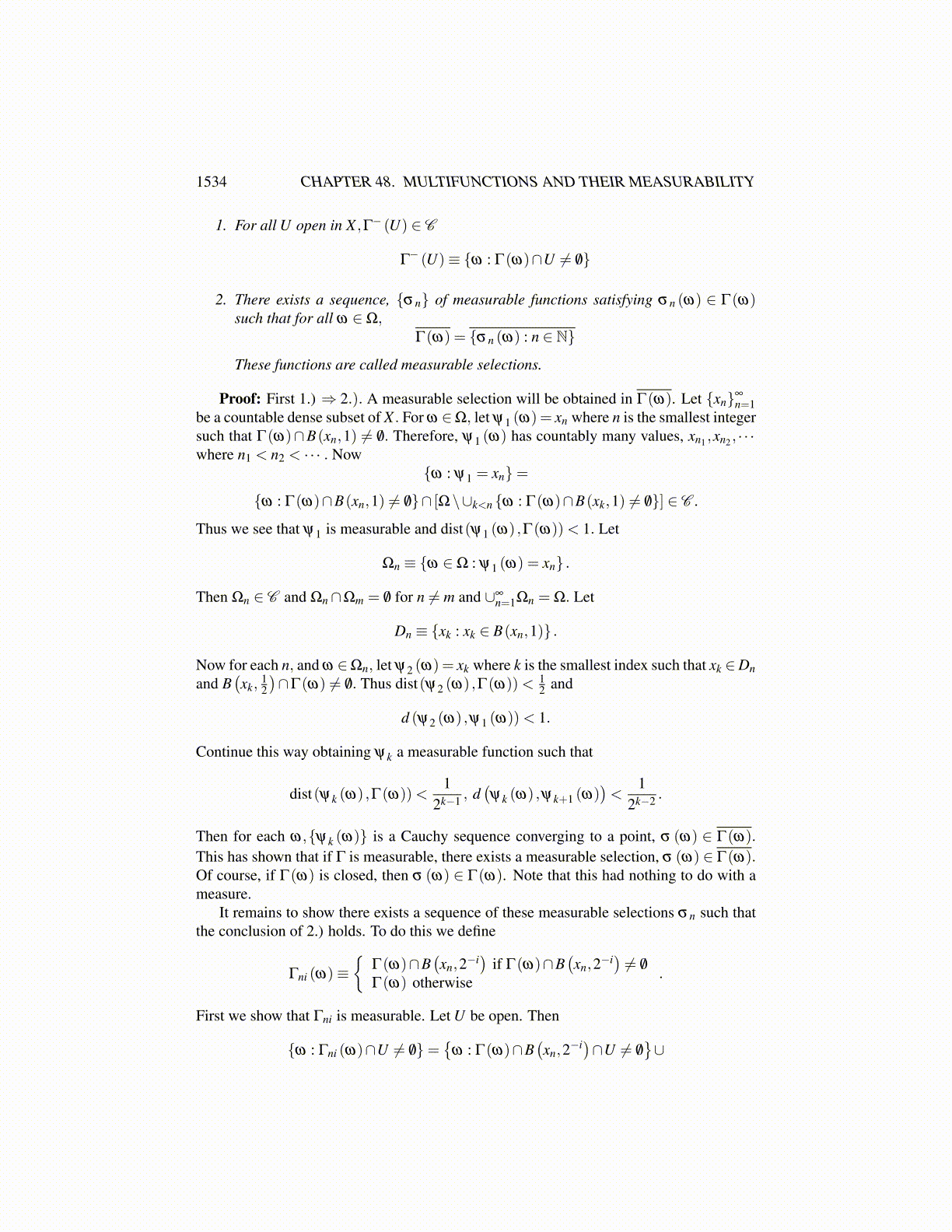
1534 CHAPTER 48. MULTIFUNCTIONS AND THEIR MEASURABILITY
Then Ωn ∈ C and Ωn∩Ωm = /0 for n ̸= m and ∪∞n=1Ωn = Ω. Let
Dn ≡ {xk : xk ∈ B(xn,1)} .
Now for each n, and ω ∈Ωn, let ψ2 (ω) = xk where k is the smallest index such that xk ∈Dnand B
(xk,
12
)∩Γ(ω) ̸= /0. Thus dist(ψ2 (ω) ,Γ(ω))< 1
2 and
d (ψ2 (ω) ,ψ1 (ω))< 1.
Continue this way obtaining ψk a measurable function such that
dist(ψk (ω) ,Γ(ω))<1
2k−1 , d(ψk (ω) ,ψk+1 (ω)
)<
12k−2 .
Then for each ω,{ψk (ω)} is a Cauchy sequence converging to a point, σ (ω) ∈ Γ(ω).
This has shown that if Γ is measurable, there exists a measurable selection, σ (ω) ∈ Γ(ω).Of course, if Γ(ω) is closed, then σ (ω) ∈ Γ(ω). Note that this had nothing to do with themeasure. It remains to show there exists a sequence of these measurable selections σn suchthat the conclusion of 4.) holds. To do this we define for Γ(ω) closed and measurable,
Γni (ω)≡{
Γ(ω)∩B(xn,2−i
)if Γ(ω)∩B
(xn,2−i
)̸= /0
Γ(ω) otherwise. .
Thus in the case of nonempty intersecton in the above cases,
Γ(ω)∩B(xn,2−(i+1)
)⊆ Γni (ω)⊆ Γ(ω)∩B(xn,2−i).
First we show that Γni is measurable. Let U be open. Then
{ω : Γni (ω)∩U ̸= /0}={
ω : Γ(ω)∩B(xn,2−i)∩U ̸= /0
}∪[{
ω : Γ(ω)∩B(xn,2−i)= /0
}∩{ω : Γ(ω)∩U ̸= /0}
]={
ω : Γ(ω)∩B(xn,2−i)∩U ̸= /0
}∪[(
Ω\{
ω : Γ(ω)∩B(xn,2−i) ̸= /0
})∩{ω : Γ(ω)∩U ̸= /0}
],
a measurable set. By what was just shown, there exists σni, a measurable function suchthat σni (ω) ∈ Γni (ω)⊆ Γ(ω) for all ω ∈Ω. If x ∈ Γ(ω) , then
x ∈ B(xn,2−(i+2)
)whenever xn is close enough to x. Thus both x,σn(i+2) (ω) are in B
(xn,2−(i+2)
)and so∣∣σn(i+1) (ω)− x
∣∣< 2−i. It follows that condition 4.) holds. Note that this had nothing to dowith the measure.
Now we verify that 4.) ⇒ 3.). Suppose there exist measurable selections σn (ω) ∈Γ(ω) satisfying condition 4.). Let U be open. Then
{ω : Γ(ω)∩U ̸= /0}= ∪∞n=1σ
−1n (U) ∈ C .